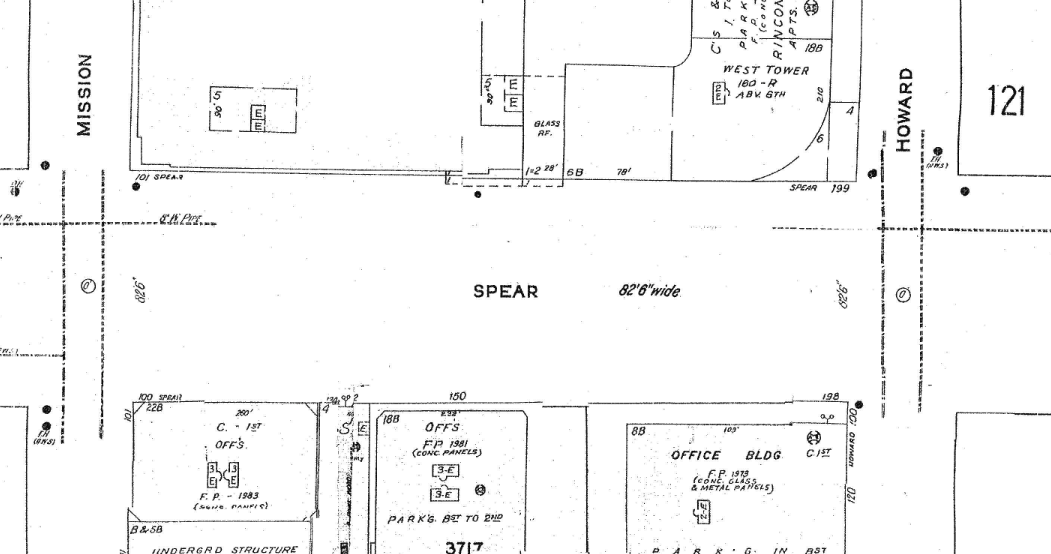San Francisco's Mission Street is 30 Mexica Hearts Wide
2022-03-20San Francisco street dimensions often don’t make sense, at least in feet. Many streets in the South of Market, including Mission Street, are 82 feet, 6 inches wide. Other streets in the Western Addition and the Mission District are 68 feet, 9 inches. In a city where any small change to traffic can become a pitched battle, these seemingly-arbitrary street widths show up time and time again.

Map of Spear Street in San Francisco
So where do these street widths come from? The answer is the vara, the unit of measurement used to draw up our early street grid. It was the default unit before San Francisco, along with the rest of California, was ceded to the U.S. following the Mexican-American war and remained so for years or decades after.
But like other units in the past a vara was not a standardized unit. Cities and regions in the Spanish-speaking world had their own particular definition of the vara, with the most common being the Spanish vara de Burgos, which measured 83.5905 cm/2.7425 feet.
But this is one case where the most common measurement is not the correct one, as confirmed by early U.S. maps, which use the Mexican vara as the unit of measurement. Slightly longer than the Spanish vara at 83.7392 cm/2.7474 feet, the Mexican vara is closer to the converted street widths. 82.5 feet and 68.75 feet become a clean 30.0 and 25.0 Mexican varas respectively.
The reasons why the Mexican vara is longer than the Spanish vara are lost in the Colonial past. And in any case, the difference is small enough where it can be easily dismissed as a rounding error (and has been for more than 170 years). But there is one important feature that appears to have been ignored until now that connects the Mexican vara to Pre-Columbian times. The official Mexican varas looted by the U.S. Army when it occupied Mexico City in 1847 are graduated in the expected tenths, hundredths, and pulgadas or Spanish inches. One Mexican vara though is divided into 48 dedos.
 Dedos or fingers in Spanish are not a common unit of measurement in the Spanish-speaking world, but it is a common Indigenous Mesoamerican unit of measurement. In the Acolhua-Mexica (the so-called Aztec) system of measurement, 48 fingers (malpilli in Nahuatl) make up one heart (yollotli), which is also the closest unit to the Spanish vara.
Dedos or fingers in Spanish are not a common unit of measurement in the Spanish-speaking world, but it is a common Indigenous Mesoamerican unit of measurement. In the Acolhua-Mexica (the so-called Aztec) system of measurement, 48 fingers (malpilli in Nahuatl) make up one heart (yollotli), which is also the closest unit to the Spanish vara.
I think that dividing the Mexican vara into 48 fingers was the result of a practical metrology arising from imperialism and conquest. By facilitating conversions between Indigenous Mesoamerican lengths, it turned the Mexican vara into a syncretic unit that bridged Pre-Columbian and Colonial eras, all the way to the present.

The vara bar with the dedo markings
Back to modern San Francisco, streets that today are 82.5 feet wide are actually 30 Mexican varas. 30 Mexican varas is 1,440 fingers, which becomes 30 Mexica yollotli or 10 tlalquahuitl wide. Streets 68.75 feet wide become 25 yollotli or 10 niquizantli wide. We begin to see distances and ratios in San Francisco found in great Pre-Columbian cities like Mēxihco-Tenōchtitlan.
Diagram from The Archaeology of Measurement: Comprehending Heaven, Earth and Time in Ancient Societies, edited by Iain Morley and Colin Renfrew, 2010
Maybe our bike lanes should be three hearts wide and sidewalks six hearts wide.
Image credits: Mexican vara photo courtesy of Jason Stoughton/NIST, table and diagram from the 2010 book “The Archaeology of Measurement: Comprehending Heaven, Earth and Time in Ancient Societies”, edited by Iain Morley and Colin Renfrew and map is the SF Sanborn map.